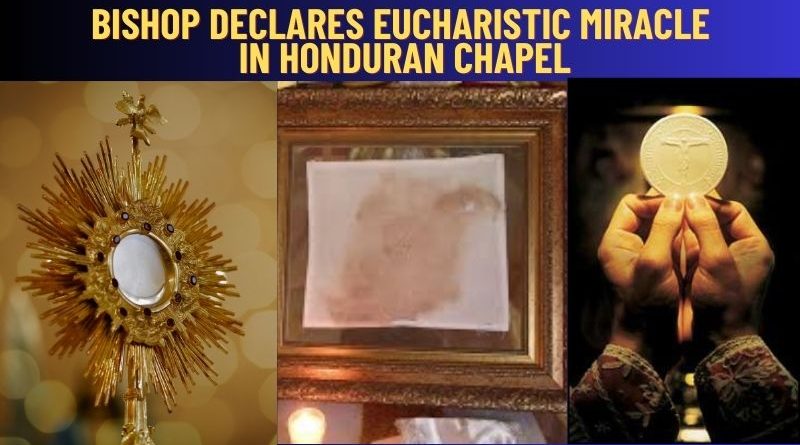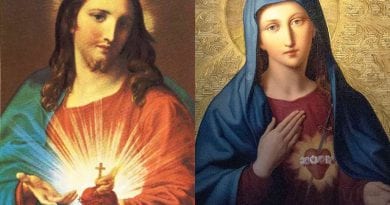BISHOP DECLARES EUCHARISTIC MIRACLE IN HONDURAN CHAPEL
Bishop Walter Guillén Soto of the Diocese of Gracias, Honduras, has declared a Eucharistic miracle that occurred in the small town of San Juan on June 9, 2022.
The miracle is said to have occurred during the celebration of Mass at the El Espinal chapel. During the Liturgy of the Word, an extraordinary minister of Holy Communion named José Elmer Benítez Machado discovered mysterious blood-like stains on the corporal cloth beneath the chalice.
Bishop Guillén Soto ordered an investigation into the matter, which included scientific tests and interviews with witnesses. After a thorough investigation, the bishop concluded that the blood stains were genuine and that they were not the result of any natural or human causes.
The bishop declared the miracle on July 21, 2023, during a special Mass at the El Espinal chapel. He said that the miracle was a sign of God’s love and presence in the world, and he urged the faithful to come to San Juan to pray and to experience the miracle for themselves.
The miracle in San Juan is the fifth Eucharistic miracle to be recognized in Latin America. The other four miracles occurred in Argentina, Bolivia, Brazil, and Mexico.
The recognition of a Eucharistic miracle is a rare event, but it is a powerful reminder of the Real Presence of Jesus Christ in the Eucharist. It is also a sign of God’s love and mercy for His people.
The miracle in San Juan is a cause for great joy and celebration for the Catholic Church in Honduras. It is also a sign of hope for the world, reminding us that God is always with us, even in the midst of difficulty.
Eucharistic miracles are events in which the consecrated host (the bread used in the Catholic Mass) or the wine used in the Eucharist is said to have changed into the physical flesh and blood of Jesus Christ. These miracles are rare, but they have been reported throughout history.
There are many different theories about how Eucharistic miracles occur. Some believe that they are simply the result of natural processes, such as the growth of mold or bacteria. Others believe that they are a sign of God’s presence and love for His people.
The Catholic Church does not officially endorse any particular theory about Eucharistic miracles. However, the Church does recognize them as a genuine phenomenon and has established a set of criteria for investigating and evaluating claims of Eucharistic miracles.
In order for a claim of Eucharistic miracle to be investigated by the Church, it must meet the following criteria:
- The event must be reported by credible witnesses.
- There must be physical evidence of the miracle, such as the host or wine that has changed into flesh and blood.
- The evidence must be subjected to scientific analysis and found to be inexplicable by natural means.
If a claim of Eucharistic miracle meets these criteria, it will be investigated by a team of experts, including theologians, scientists, and historians. The team will gather all of the available evidence and assess whether or not it is sufficient to support the claim of a miracle.
If the team concludes that the evidence is sufficient, the case will be presented to the local bishop. The bishop will then decide whether or not to declare the miracle to be authentic.
There have been hundreds of claims of Eucharistic miracles throughout history. However, only a small number of these claims have been officially recognized by the Catholic Church.
Some of the most famous Eucharistic miracles include:
- The Miracle of Lanciano, Italy (700 AD): A priest in Lanciano, Italy, reportedly saw the host he was about to consecrate change into flesh and blood. The flesh and blood have been preserved in a monstrance in Lanciano ever since Miracle of Lanciano, Italy
- The Miracle of Siena, Italy (1330 AD): A woman named Margaret of Metola reportedly saw the host she was about to receive change into flesh and blood. The flesh and blood have been preserved in a monstrance in Siena ever since.
- The Miracle of Buenos Aires, Argentina (1996 AD): A woman named Amelia Maricevich reportedly saw the host she was about to receive change into flesh and blood. The flesh and blood have been preserved in a monstrance in Buenos Aires ever since
Eucharistic miracles are a reminder of the Real Presence of Jesus Christ in the Eucharist. They are also a sign of God’s love and mercy for His people.




